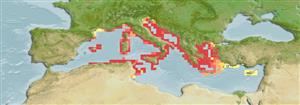Environment: milieu / climate zone / depth range / distribution range
Ecologia
marinhas; Água doce; estuarina bentopelágico; pH range: 6.5 - 7.5; dH range: 8 - 10; não migratória. Subtropical; 10°C - 24°C (Ref. 1672); 46°N - 34°N, 2°E - 36°E
Europe: France, Italy, Slovenia, Croatia, Albania, Greece and Montenegro. Mediterranean basin: North Africa from Egypt to eastern Algeria, sometimes in landlocked basins; through the Suez Canal into the Bitter Lakes, Egypt (Ref. 3788). Asia: Turkey.
Tamanho / Peso / Idade
Maturity: Lm ? range ? - ? cm
Max length : 6.8 cm TL macho/indeterminado; (Ref. 42455)
Raios anais : 9. Can be diagnosed from other species of Aphanius, Valenciidae and Fundulidae in Europe by having the following characters: males have pale yellow to yellow-orange caudal fin, in some populations with a wide dark submarginal bar, 8-15 dark blue to grey bars on a silvery background, bars usually regularly shaped and set; females possess 11-17 short dark brown bars on sides, over a faint greyish midlateral stripe, 24-29 scales in midlateral series on body, and pectoral fin with 14-15 rays (Ref. 59043).
Occurs in coastal lagoons and in hypersaline to shallow still to slow-flowing fresh water, especially at river mouths (Ref. 59043). A short-lived species which inhabits ponds, ditches and swamps. Feeds on invertebrates and plants. Spawns from April to September (Ref. 26100). Spawning takes place on the bottom and in submerged vegetation (Ref. 59043).
Threatened due to habitat destruction and the introduction of other species (Ref. 26100). Not a seasonal killifish. Is difficult to maintain in the aquarium (Ref. 27139).
Ciclo de vida ou comportamento de acasalamento
Maturidade | Reprodução | Desova | Ovos | Fecundidade | Larvas
Freyhof, J. and B. Yoğurtçuoğlu, 2020. A proposal for a new generic structure of the killifish family Aphaniidae, with the description of Aphaniops teimorii (Teleostei: Cyprinodontiformes). Zootaxa 4810(3):421-451. (Ref. 126233)
Status na Lista Vermelha da UICN (Ref. 130435)
Ameaça para os humanos
Harmless
Uso pelos humanos
Pescarias: sem interesse; Aquário: Espécies comerciais
Mais informação
ColaboradoresFotosStamps, Coins Misc.SonsCiguateraVelocidadeTipo de nataçãoÁrea branquialOtólitosCérebrosVisão
Ferramentas
Relatórios especiais
Baixar XML
Fontes da internet
Estimates based on models
Preferred temperature (Ref.
123201): 17.6 - 20.1, mean 18.9 °C (based on 346 cells).
Índice de diversidade filogenética (Ref.
82804): PD
50 = 0.5000 [Uniqueness, from 0.5 = low to 2.0 = high].
Bayesian length-weight: a=0.01000 (0.00808 - 0.01238), b=3.24 (3.20 - 3.28), in cm total length, based on LWR estimates for this species (Ref.
93245).
Nível Trófico (Ref.
69278): 2.7 ±0.27 se; based on food items.
Resiliência (Ref.
120179): Elevada, tempo mínimo de duplicação da população menor que 15 meses (K=0.16-0.22 questionable; assuming tm<1).
Fishing Vulnerability (Ref.
59153): Low vulnerability (10 of 100).
